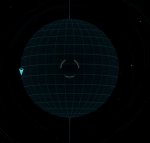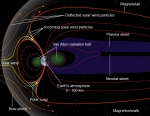Out of curiosity, are you guys searching with a UA in your cargohold?
I have seen mine roll up hill when dropped, how long do they last again out of the buggy/ship?
Out of curiosity, are you guys searching with a UA in your cargohold?
I've now gone halfway across Maia A 2 B along the equator with nothing to report other than finding Taaffeite at a mining facility.
When it comes to the whole barnacles filtering "neutrients" from the nebula gas angle I think this is looking in the wrong direction. IMO they're called barnacles because that's what they look like (see exhibit A: Horizons trailer), not because of being otherwise identical with earth-barnacles. We know they like nebulae. From what I understand nebulae have a high density of "interesting" materials. These materials are primarily found in the planets rather than in the nebula dust. (The science here is probably inaccurate, I'm "paraphrasing"). Others have theorized that barnacles "mine" planets of materials and as part of an organic process turn these into meta-materials, I agree with this. This tells me we should look at high-metal planets in nebulae with a high occurance of specific materials. The question is which materials?
My suggestion of a methodical approach would be mapping the occurance of rare materials on planets in the Meirope nebula. To start with a narrow band we could limit it to 100% metal planets and only materials from metallic meteorites. What do you guys think, any of this making sense?
I've now gone halfway across Maia A 2 B along the equator with nothing to report other than finding Taaffeite at a mining facility.
When it comes to the whole barnacles filtering "neutrients" from the nebula gas angle I think this is looking in the wrong direction. IMO they're called barnacles because that's what they look like (see exhibit A: Horizons trailer), not because of being otherwise identical with earth-barnacles. We know they like nebulae. From what I understand nebulae have a high density of "interesting" materials. These materials are primarily found in the planets rather than in the nebula dust. (The science here is probably inaccurate, I'm "paraphrasing"). Others have theorized that barnacles "mine" planets of materials and as part of an organic process turn these into meta-materials, I agree with this. This tells me we should look at high-metal planets in nebulae with a high occurance of specific materials. The question is which materials?
My suggestion of a methodical approach would be mapping the occurance of rare materials on planets in the Meirope nebula. To start with a narrow band we could limit it to 100% metal planets and only materials from metallic meteorites. What do you guys think, any of this making sense?
We are aware of some of the crashes that happen around POI's so there are some fixes lined up that will hopefully catch most if not all of these.
Having said that DO please keep sending the automatic crash reports and DO keep reporting these crashes on our forums in the bug reports section. That way our QA team will have plenty to do and hopefully we can catch anything else that is causing crashes that we haven't fixed yet.
I hope we will be able to release a patch with these fixes soon.
Cheers,
CMDR Falcon
That's very interesting! it's deadcenter!
probably the white in the mittle is the sun? ( just thinking out loud now)
We should probably look a little bit more in this.

Agreed. Very grateful for the explanation of game mechanics; barnacles not visible from super cruise, will load if you're in ship or SRV, etc, but actual hints should be limited to GalNet news and in-game means.
Frontier Support replied to a reddit thread about possible crashes when getting near a Barnacle POI. They didn't confirm that the crashes are related to Barnacle POIs but did say fixes were being lined up.
https://www.reddit.com/r/EliteDangerous/comments/40mqq3/is_the_barnacle_search_broken_i_would_not_waste/cyvmu6s
Excellent, thanks! There's been so many people posting links to spreadsheets mapping various things I've completely lost track. I'll focus on helping you guys with this from now on thenA couple of us started doing this. https://docs.google.com/spreadsheet...ligUFw79RnXmPPH0H8TAw/edit?pref=2&pli=1#gid=0
Watch out CMDR's there are some player killers out tonight, ASP's with Rails... 2 CMDRs dead already. I am out in a corvette let me know if you need assistance.
EDIT: Make that Anaconda and ASP's... CMDR Comrade & CMDR Daylightm
why? because the stadium this references has an ice RINK ? It iss also used for basketball games.
Excellent, thanks! There's been so many people posting links to spreadsheets mapping various things I've completely lost track. I'll focus on helping you guys with this from now on then
When it comes to the Staples Center clue, is there anything at all connecting it to barnacles? I'll bet 5 tea canisters it's a red herring.
IRL nebula and Pleiades are not linked directly. Pleiades just fly through this nebula. It is reflection nebula, not a star remnant nebula. However we are not irl.
The article you have found is about Wolf-Rayet stars.
It's very hard to extract material from nebula because it's very sparse. Material probably will not fall to planets because of strong solar wind from B-type star. You need a big spacecarft to collect material. It's much more easy to extract needed materials from a planet.
Why nebulas? They attract explorers and give you light at nighttime. You can hide something very big and bright in big and bright nebula. What else?
This birth of a new star occurs approximately 100,000 years after the collapse begins.[1] Objects at this stage are known as Class I protostars,[9] which are also called young T Tauri stars, evolved protostars, or young stellar objects.[9] By this time the forming star has already accreted much of its mass: the total mass of the disk and remaining envelope does not exceed 10–20% of the mass of the central YSO.
At the next stage the envelope completely disappears, having been gathered up by the disk, and the protostar becomes a classical T Tauri star. This happens after about 1 million years.
T Tauri stars are the youngest visible F, G, K, M spectral type stars (<2 M☉).

When it comes to the Staples Center clue, is there anything at all connecting it to barnacles? I'll bet 5 tea canisters it's a red herring.
I meant to say earlier, I just found out that I can actually run Horizons on my dinky little Mac Mini so I might join up with you guys searching planets in the Pleiades and/or other nebulae later this week (have to trek back from Sag A* first).
If you're out that far, don't come back to the Pleiades to search. We've been told barnacles can be found in other nebulae as well. Search in ones out there.
Watch out CMDR's there are some player killers out tonight, ASP's with Rails... 2 CMDRs dead already. I am out in a corvette let me know if you need assistance.
EDIT: Make that Anaconda and ASP's... CMDR Comrade & CMDR Daylightm
